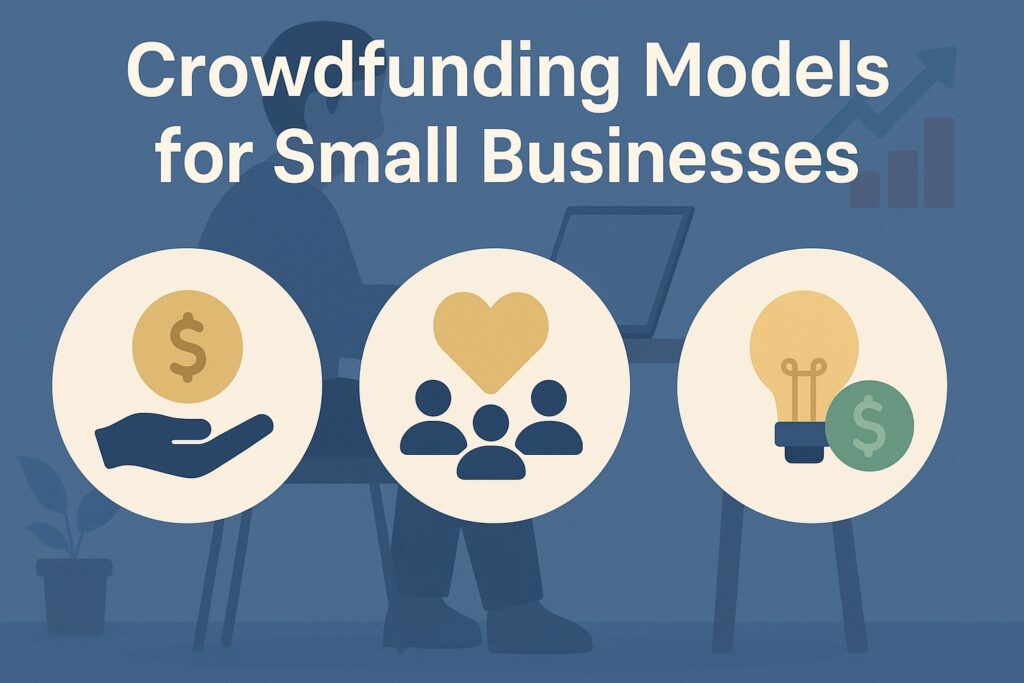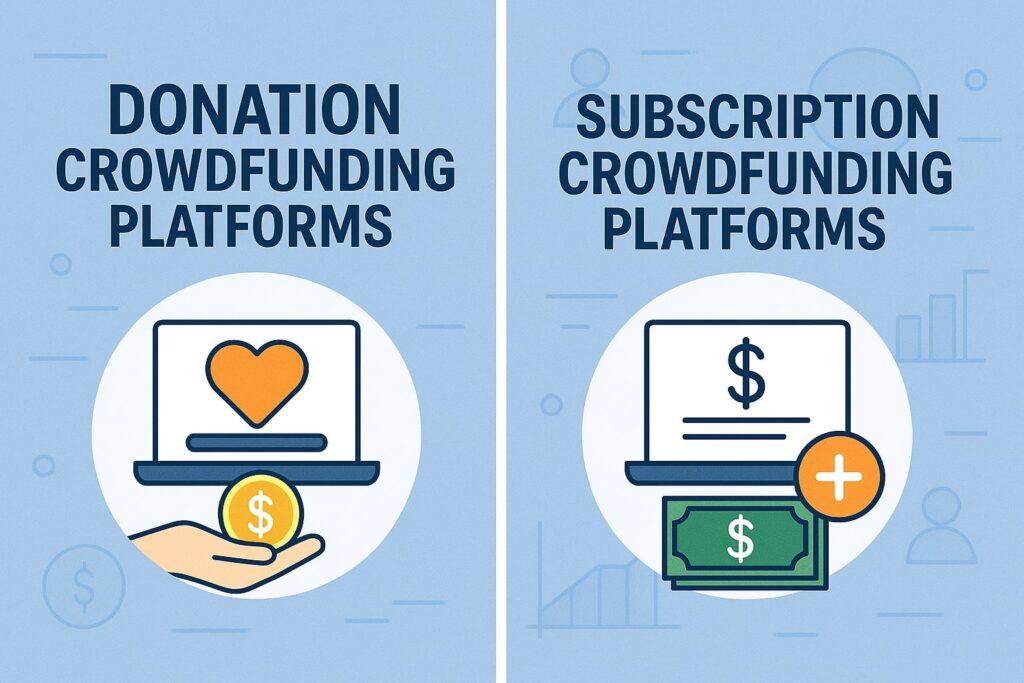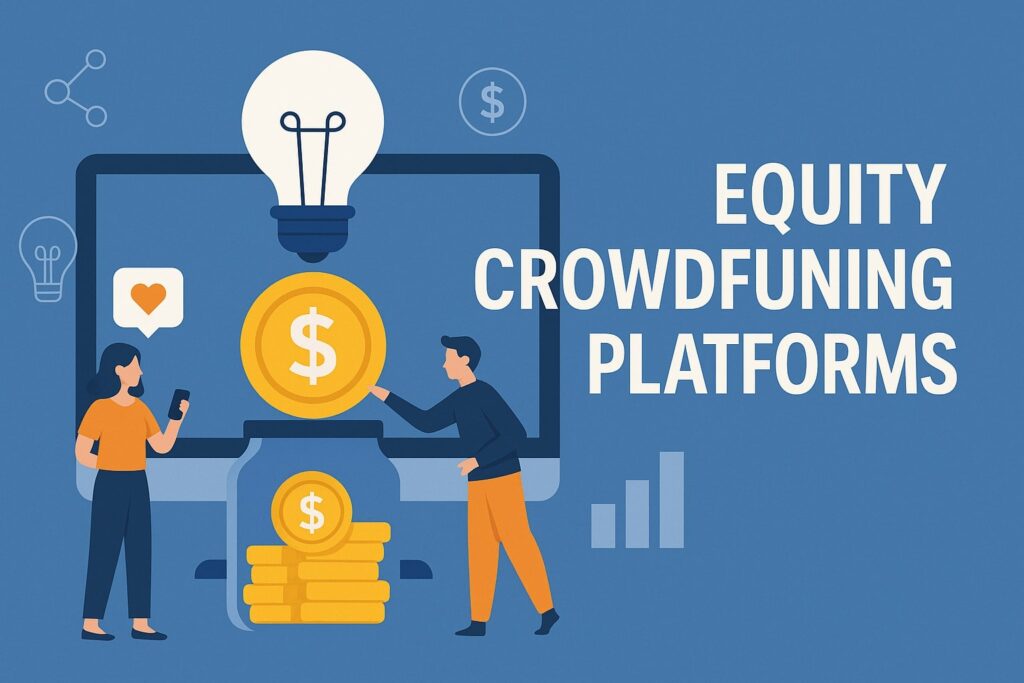
Latest Crowdfunding Platforms for Small Business Owners
Crowdfunding has become a vital financing avenue for U.S. small businesses across industries. Whether you’re launching a tech gadget, funding a creative project, or stocking a retail inventory, the latest crowdfunding platforms for small business owners offer alternative funding sources beyond traditional loans.
In 2024 the North American crowdfunding market generated roughly $660.6 million in revenue, and reward-based crowdfunding alone is projected to contribute over $1.05 billion to the U.S. economy in 2025.
These platforms not only raise capital but also validate ideas and build communities – “tapping into thousands of potential backers who might love your idea”. Success is never guaranteed (less than half of campaigns fully fund), so choosing the right model and platform is critical.
In this article we survey the latest U.S. crowdfunding platforms – from big names like Kickstarter and Indiegogo to equity portals like Wefunder and StartEngine – across all funding models.
We explain reward-based (pre-sale) campaigns, donation drives, subscription/membership funding, and equity offerings under SEC rules. We’ll compare fees, features, and success rates, and highlight platforms suited to tech startups, creative ventures, retail stores, and more.
By the end, you’ll understand how these platforms work, how they differ, and how to pick one that fits your small business goals.
Crowdfunding Models for Small Businesses

Crowdfunding isn’t one-size-fits-all. Broadly, platforms fall into several funding models:
- Reward-based crowdfunding: Backers pledge funds in exchange for products or perks. It’s typically project-focused. Kickstarter and Indiegogo are classic examples.
Campaigns are often all-or-nothing (funders only pay if the goal is met) or fixed-goal/flexible (funds keep regardless of goal). This model is ideal for launching new products or creative ventures, as it doubles as marketing and pre-selling. - Donation-based crowdfunding: Contributors give money without expecting equity or goods. GoFundMe is the leading donation site for individuals and causes.
Small businesses sometimes use donation campaigns for community projects or emergency relief. Donation platforms typically let you keep all funds raised (no “all-or-nothing” rule). - Subscription/membership funding: Platforms like Patreon and Ko-fi let fans or customers support creators on an ongoing basis.
Instead of a single project, creators (artists, podcasters, etc.) set up tiers of recurring payments for perks. This model builds a community and steadies cash flow. - Equity crowdfunding: Under SEC regulations (Reg CF, Reg A+, etc.), businesses sell shares or revenue rights to many investors online. Portals like Wefunder, StartEngine, and Republic enable non-accredited investors to fund startups in exchange for equity.
These platforms require extensive disclosures (business plan, financials) and compliance, but allow raising larger sums (up to $5M under Reg CF). - Debt/loan crowdfunding: Some sites facilitate loans instead of equity. For example, Kiva.org offers interest-free microloans, and newer platforms like Honeycomb Credit let local businesses borrow from community lenders.
These function like crowd-sourced small business loans rather than donations or investments.
When choosing a model and platform, entrepreneurs should align the campaign type with their goals and audience.
For example, a gadget maker might do a Kickstarter to pre-sell a device, while a startup seeking larger capital might file an equity offering on StartEngine. Key factors include fees, campaign rules, audience, and support tools offered. We will cover the major platforms by model next.
Top Reward-Based Crowdfunding Platforms

Kickstarter – All-or-Nothing Product Launches
Kickstarter is the most famous reward-based platform for creative and product projects. Since its 2009 launch, its community has funded over 284,000 projects. Kickstarter campaigns must reach their stated goal to collect any funds (“all-or-nothing” model).
Backers pledge in return for rewards (e.g. early-bird discounts, exclusive merchandise). This model can generate buzz and validate ideas – successfully funded campaigns often become newsworthy launches.
- Fees: 5% platform fee on funds raised, plus payment processing fees (about 3–5% plus $0.30 per pledge).
- Success Rate: Historically around 40–50% of projects succeed. (Kickstarter reported roughly 41.98% of campaigns had reached their goals by early 2025, up from ~37.7% in earlier data.) Success tends to be higher for standout categories: for example, “Games” projects saw ~64% success in Q1 2023.
- Audience: Large community of backers worldwide. Particularly strong for innovative gadgets, arts, games, and design. Backers expect well-defined rewards and timelines.
- Notable: Kickstarter rigorously vets campaigns, which builds trust; backers pay only if the project fully funds. However, if the goal isn’t met, the campaigner receives nothing and owes nothing.
Pros: Very high visibility, strong project curation, large user base. All-or-nothing funding motivates push towards the goal.
Cons: No partial funding – if you miss the goal, you get $0. High competition for attention. 5% fee plus processing (for example, a $10 pledge costs the creator ~$0.88 after fees).
Indiegogo – Flexible Funding for Diverse Projects
Indiegogo (est. 2008) is another major U.S. platform, serving entrepreneurs, artists, and nonprofits. Unlike Kickstarter, Indiegogo offers both Fixed Funding (all-or-nothing) and Flexible Funding options.
Under Flexible Funding, a campaign keeps whatever money is raised, even if it falls short of the goal. This can be useful for multi-stage projects (you can use initial funds to deliver some rewards and then raise more).
Indiegogo also offers an “InDemand” feature to continue fundraising after the campaign ends, allowing post-campaign pre-orders or additional funding.
- Fees: Indiegogo charges a 5% platform fee on all funds raised (after July 2025, when it was standardized). Transaction fees are about 3% + $0.20 per contribution.
(Prior to mid-2025, unmet flexible campaigns paid a higher 9% fee, but after the platform was acquired by Gamefound, pricing was reset to 5% flat.) - Success Rate: Historically lower than Kickstarter. A mid-2025 report noted Kickstarter had funded more projects than Indiegogo and enjoyed higher success rates (Kickstarter ~37.7% vs Indiegogo ~13.1% in the period studied). Note that Indiegogo’s flexible option likely affects its success metrics.
- Audience: Broad – tech gadgets, health devices, creative campaigns, social causes. Indiegogo is slightly smaller than Kickstarter but still well-known.
- Notable: The flexible funding option provides a safety net of sorts. “InDemand” lets you keep momentum post-launch.
Pros: Flexible funding option; campaigns don’t have to fail outright. InDemand feature for ongoing sales. Wide range of project categories.
Cons: Smaller community and typically lower success. 5% fee plus processing (no all-or-nothing incentive unless you choose fixed).
Other Reward-Based Platforms
- Fundable (Startups.com): Offers both reward and equity crowdfunding for small business startups. It is geared to U.S. startups with options to run either a reward (pre-order) or equity campaign. It provides campaign support services (pitch deck help, investor leads).
Fees: $179 per month (flat) with no additional success fee. Use: Good for tech startups with investor interest. (Equity campaigns on Fundable can raise more capital, while reward campaigns often get more backers.) - Shopify Crowdfunder App: A unique tool for e-commerce retailers. Instead of an independent site, it lets Shopify store owners add a “crowdfunding” or pre-order button directly to their product page.
It uses a keep-it-all model: shoppers pre-order the item, and the merchant pays a flat monthly fee ($24) instead of per-transaction fees.
Fee: $24/month. Use: Best for Shopify-based retail businesses testing a product without wanting the hassle of a full campaign platform. (No built-in crowd or marketplace – it relies on your existing customers.)
Features and Tools for Reward Campaigns
Many reward platforms provide marketing tools (campaign pages, updates, video upload) and community support. For example, Kickstarter and Indiegogo offer embedded video players and social sharing.
Shopify’s analysis notes that platforms were also evaluated on “tools and features” like campaign management, analytics, and integrations. Indiegogo’s InDemand helps extend sales, while Kickstarter’s brand recognition helps attract press.
In any case, a compelling pitch page (story, video, clear rewards) is essential: campaigns with a strong narrative and early momentum are far more likely to succeed.
Donation and Subscription Crowdfunding Platforms

GoFundMe – Donation-Based for Causes and Support
GoFundMe is the dominant U.S. donation crowdfunding site. It is free to use for fundraisers (no platform fee). Instead, GoFundMe charges a standard payment processing fee of 2.9% + $0.30 on each donation.
The platform is geared to personal causes, charity drives, and community projects. While not designed for commercial ventures, some small businesses use it in tight situations (e.g. disaster relief for a store, or community-funded loans).
- Funding Model: GoFundMe operates on a keep-it-all model with no goal requirement. You can withdraw funds immediately (it’s not an all-or-nothing platform).
- Success Rate: Donation campaigns can succeed easily if tied to a compelling personal story or cause. The platform’s total metrics include over $15 billion raised globally (with $2.5B of that in 2023).
However, success heavily depends on personal networks and promotion; there is no vetting of commercial viability. - Use: Best for fundraising around personal or community causes (e.g. helping a small business rebuild after a fire) rather than marketing a new product.
Pros: 100% of donor money (minus payment fees) goes to you. Very easy to set up. Large user base for charity giving.
Cons: Not meant for business ventures or product pre-sales. Funds must be spent as promised (if charitable), and success often hinges on social media sharing.
Patreon – Subscription Crowdfunding for Creators
Patreon is a membership platform, popular with podcasters, YouTubers, artists, and other content creators.
Instead of a one-off campaign, creators invite fans to pay a monthly (or per-creation) subscription in exchange for perks (exclusive content, behind-the-scenes access, merchandise, etc.). This model builds an ongoing community of supporters.
- Fees: Patreon takes a 10% platform fee on all creator earnings. There’s also a payment processing fee starting at 2.9% + $0.30 for payments over $3. (Creators choose between monthly billing or per-work billing.)
- Use: Ideal for content-driven businesses – musicians, writers, video creators, games – who can sustain a paying fanbase over time. Not suited to one-off projects or non-creative businesses.
- Notable: Patreon offers integrations for newsletters, live streams, communities, and storefronts, emphasizing community-building.
Pros: Creates recurring revenue and loyal customers. Tools for audience engagement and reward tiers.
Cons: Higher fees (10% platform + processing). Not for single projects (you must continually produce content). Building a Patreon following can take time.
Other Donation/Subscribers Platforms
- Fundly / GiveButter / CrowdRise: These are donation-style platforms aimed at nonprofits and causes.
They usually charge platform fees and processing fees. (For example, Crowdrise/GoFundMe [Crowdrise rebranded as GoFundMe].) They are less relevant to commercial small businesses. - Ko-fi / Buy Me a Coffee: Similar to Patreon, but simpler. Typically no platform fee (or small fee on optional premium tiers) and payment fees around 2-3%. Good for very small creators or one-off donations.
Equity Crowdfunding Platforms

Regulation crowdfunding (Reg CF) opened equity fundraising to everyday investors. U.S. companies can now raise up to $5 million per 12-month period from non-accredited investors. The space is led by platforms like Wefunder, StartEngine, Republic, and others.
These are investment platforms – backers become part-owners (or debt-holders) and campaigns require detailed disclosures.
Wefunder – “Democratizing” Startup Investing
Wefunder (est. 2012) is the largest U.S. equity crowdfunding portal. It supports Regulation CF offerings up to $5M, plus some Reg A+ and Reg D deals. Wefunder’s tagline is making startup investment accessible to all.
- Platform Fee: Wefunder charges a 7.9% success fee on the amount raised (no upfront fee). It also charges an annual $1,000 admin fee post-campaign for compliance services (not collected unless you raise funds).
- Volume: In 2024 Wefunder raised about $99.4 million for U.S. companies. It has a large investor base (over 500,000 signups).
- Use: Good for early-stage startups with a compelling story and consumer base. Typical minimum investments can be as low as $100, making it easy to attract many small investors.
- Notable: Offers free investor education and “how-to” support. Startups gain marketing exposure to an investor community.
Pros: Access to a broad pool of investors (many non-accredited). Successful track record and high brand recognition in Reg CF. Wefunder handles legal paperwork and investor relations tools.
Cons: 7.9% fee is relatively high. Extensive due diligence and compliance (SEC filings, audits, annual reports) are required. Campaigns must be marketed to attract investors – not easy if the product is niche.
StartEngine – Equity for High-Growth Startups
StartEngine (est. 2015, originally SeedInvest) is a major equity crowdfunding site based in Los Angeles. It supports Regulation Crowdfunding and Regulation A+ campaigns. It markets itself toward “high-growth” or venture-backed startups.
- Platform Fee: StartEngine’s commission ranges from 5.5% to 13% of the capital raised, paid on close of the offering. (Exact percent depends on campaign specifics.) Investors also pay a small fee on cash (0 – 3.5%).
- Volume: In 2024, StartEngine helped raise about $86 million (second only to Wefunder). Notably, StartEngine acquired the assets of competitor SeedInvest in 2023, consolidating its position.
- Use: Targeted at startups with some traction and growth plans. StartEngine provides investor education, and offers “rolling closes” (campaign can close once its target is hit). Companies often keep their campaign open to allow oversubscriptions.
- Notable: StartEngine assists with investor relations, legal docs, and marketing materials. It allows companies to cap raises at $1,070,000 to avoid full audit requirements, making small raises cheaper.
Pros: Established platform, growing investor network (1.8M+ users). Offers both Reg CF and Reg A+ (up to $75M). Access to affiliates and special perks for larger raises.
Cons: Lower success rate (reportedly ~75% of published campaigns reached goal, though real average is likely lower). Complex preparation (financial audits, disclosures). Fee is high on the high end (13%).
Republic – Equity (and Rewards) in One Place
Republic (founded 2016) is an investment platform that also hosts rewards campaigns and debt offerings. It merged with Seedrs (EU’s major platform) in 2021 and now operates in the U.S. (Reg CF) and Europe.
- Platform Fee: For successful U.S. raises, Republic charges a 7% fee on funds raised plus 2% of the securities issued. (Investors pay a separate processing fee if using a credit card.)
- Volume: In 2024 Republic ranked fourth among U.S. Reg CF platforms, raising ~$15.6 million domestically. It also has a large international operation.
- Use: Attracts startups especially in tech, blockchain, and fintech (Republic has a strong crypto focus). Republic offers portfolio management tools and a secondary market.
- Notable: Republic supports Reg CF (up to $5M) and Reg D (accredited only) on one platform. They also invest in promising deals through a scout program.
Pros: Easy-to-use platform with global reach. Secondary market for some investments. Offers guidance on regulatory compliance.
Cons: Fees (especially the 7% cut) are significant. In 2024 Republic’s U.S. deal volume was much lower than the top two, which may reflect tougher competition.
Other Equity Crowdfunding Options
- DealMaker Securities: A financial services firm that provides tech for both Reg CF and Reg A+ raises. In 2024 DealMaker raised ~$49M across campaigns. Fees are deal-specific. Many traditional private funds use DealMaker’s platform.
- Equifund, Netcapital, Honeycomb Credit: Smaller U.S. platforms. Each raised roughly $9–10M in 2024. Equifund offers Reg CF (for accredited/non-accredited). Netcapital targets growth companies.
Honeycomb Credit focuses on loans to local small businesses via Reg CF (investors earn interest). - SeedInvest: Formerly a leading Reg CF portal, it was acquired by StartEngine in 2023 and merged into its platform.
- Regulation A+ Platforms: Platforms like WeGrow (Dalmore) and others handle larger offerings under Reg A (up to $75M). These cater to more mature companies; Reg A+ raised $244M in 2024. (For most small businesses, Reg CF is more accessible.)
Regulatory Context
Equity crowdfunding in the U.S. operates under SEC rules. Regulation Crowdfunding (Title III of the JOBS Act) permits raises up to $5M per year. (Previously the cap was $1.07M; it was raised to $5M in March 2021.) Regulation A+ allows public offerings up to $75M, but carries more requirements.
(Accredited investor platforms under Reg D exist too, but those are less of a “platform” and more private placements.) All equity crowdfunding platforms must be SEC-registered or SEC-exempt funding portals, and companies must file disclosures (Form C) with the SEC.
For founders, these platforms offer a “streamlined” alternative to venture capital, but still demand solid business plans, financial projections, and ongoing reporting.
As one expert notes, equity crowdfunding is “about more than raising money” – it builds a community of engaged investors and can validate the market need.
Comparing Crowdfunding Platforms: Fees, Features, Success
Choosing among crowdfunding platforms involves comparing fees, funding rules, and track record. The examples below illustrate the range (sources in footnotes):
- Kickstarter (Reward-based): 5% fee + ~3–5% payment processing; all-or-nothing funding; backed ~284k projects so far; ~40%+ success rate.
- Indiegogo (Reward-based): 5% fee + 3% + $0.20 processing; fixed or flexible funding options; flexible funding means you keep money even if goal unmet.
- Patreon (Subscription): 10% of creator income + ~3% processing; ongoing monthly model; builds recurring support.
- GoFundMe (Donation): 0% platform fee; 2.9% + $0.30 processing; keep-all, instant withdrawals; great for charity/personal drives.
- Fundable: $179/month, no extra fee; supports reward or equity campaigns; aimed at startups.
- Crowdfunder (Shopify app): $24/month; converts e-commerce product pages into pre-order campaigns; useful for retail products.
- WeFunder (Equity): 7.9% platform fee on success; allows Reg CF raises up to $5M; largest U.S. equity crowdfund network (raised ~$99M in 2024).
- StartEngine (Equity): 5.5–13% fee; supports Reg CF and Reg A+; raised ~$86M in 2024.
- Republic (Equity): 7% + 2% of equity; handles Reg CF (and crypto); U.S. platform (also Europe).
- DealMaker (Equity/Debt): Custom fees; used by private capital raises.
- Honeycomb Credit (Debt): Provides loans to local businesses via Reg CF; example of debt model.
- Mightycause (Donation for nonprofits): 0% platform fee (free plan); 1.9%+ per donation; tools for peer-to-peer and event fundraising; nonprofit focus.
The success rate varies by model. On average, only ~22–24% of all crowdfunding campaigns are fully funded. Reward-based projects tend to do better (~39–40% success) because tangible rewards and smaller goals make backing easier.
Equity raises succeed less often (~20%), given their higher thresholds. Donation campaigns can hit 25–30% success if the story resonates.
Note that rates differ per platform: Kickstarter’s success is generally higher than Indiegogo’s, and Seed & Spark (film) boasted an 82% success rate by requiring an 80% funding threshold.
Table: Comparison of Major Crowdfunding Platforms (U.S.)
| Platform | Type / Model | Fee Structure | Example Use / Notes |
|---|---|---|---|
| Kickstarter | Reward-based (all-or-nothing) | 5% platform fee + ~3–5% payment fees | Creative projects, tech gadgets; requires meeting the full goal. |
| Indiegogo | Reward-based (flexible or fixed) | 5% platform fee + 3% + $0.20 transaction | Flexible funding option allows keeping funds even if goal not met. |
| Patreon | Subscription membership | 10% of income + 2.9% + $0.30 processing | Recurring creator support; for content creators and artists. |
| GoFundMe | Donation-based (keep-all) | 0% platform fee; 2.9% + $0.30 processing | Personal causes, community projects; not intended for commercial products. |
| Fundable | Reward or Equity (self-managed) | $179/month (no success fee) | For startups to offer either rewards or equity; includes campaign support. |
| Crowdfunder (Shopify) | Pre-order app (reward) | $24/month | Converts Shopify product pages into preorder campaigns; no marketplace support. |
| WeFunder | Equity (Reg CF) | 7.9% of funds raised (plus $1k/yr admin) | Largest Reg CF portal; low investment minimum (~$100). Raised ~$99M in 2024. |
| StartEngine | Equity (Reg CF / A+) | 5.5–13% commission | For high-growth startups; rolled out Reg A+; raised ~$86M in 2024. |
| Republic | Equity (Reg CF, crypto) | 7% of funds + 2% of securities | Multi-model (equity, debt, crypto); ~$15.6M raised in 2024. |
| DealMaker | Equity/Debt (Reg CF/A+) | Custom (varies per deal) | Financial firm for both Reg CF and Reg A+ offerings; ~$49M in 2024. |
(Fees and statistics are illustrative; always confirm current terms on each platform.)
Choosing the Right Crowdfunding Platform
With many platforms available, small businesses should consider several factors:
- Audience & Fit: Is the platform’s community aligned with your industry? For example, Kickstarter excels at tech gadgets and creative goods, while Patreon suits ongoing content creators.
Niche platforms (e.g. Seed&Spark for film, Honeycomb for local business loans) might serve specific cases. - Fees and Costs: Compare platform fees, payment processing, and any subscription costs.
Flat-fee models (Crowdfunder’s $24/mo) avoid variable charges, whereas percentage fees scale with the raise. Remember to factor in payment gateway fees too (typically 2–3%). - Funding Rules: Decide between fixed vs flexible funding. All-or-nothing (Kickstarter) can motivate backers but is risky if you miss the goal.
Flexible models (Indiegogo Flexible, GoFundMe) give you funds raised even if under goal. Consider timing: some platforms cap campaign lengths (30–60 days), others allow rolling campaigns. - Support and Tools: Look for platforms that offer campaign support. Some provide marketing tools, analytics, or help with pitch materials.
For instance, equity platforms often assist with legal filings and may even review your business plan. Shopify’s analysis notes that good platforms offer usability, marketing integrations, and success support. - Track Record: Research each platform’s success history. Generally, Kickstarter-funded campaigns validate product-market fit, while Reg CF sites help vet startups by attracting investors.
For example, SeedInvest and Crowdcube (European) have a funding club for successful campaigns. Use published stats: Shopify and others highlight known success examples and rates.
In summary, there is no one “best” platform for all small businesses. Your choice should match your industry, funding goals, and audience. For example, a local café might run a GoFundMe or Honeycomb loan, while a software startup might pursue a Reg CF round on Wefunder.
Tech product companies often launch on Kickstarter or Indiegogo and then consider an equity round later. Many entrepreneurs also combine crowdfunding with grants or loans for a diversified approach.
Key Crowdfunding Considerations
- Realistic Funding Goals: Over-ambitious targets tend to fail. Experts advise setting goals that cover costs but are achievable. Consider pre-launch promotion to build momentum (campaigns that raise 30% of goal in week one are ~75% likely to succeed).
- Compelling Story & Rewards: A clear, engaging narrative and attractive rewards (for reward crowdfunding) significantly boost success. Include high-quality videos or prototypes – campaigns with video raise ~105% more.
- Transparency and Trust: Especially for equity crowdfunding, full transparency is required. Provide business plans, financials, and communicate regularly with backers/investors to build trust. Platforms are increasingly emphasizing investor protection via disclosures.
- Legal and Tax Obligations: Crowdfunding proceeds may be taxable (even donations in some cases). Equity raises carry SEC reporting duties (annual reports, etc.). Failure to comply can incur penalties. Seek legal advice if planning an equity campaign.
- Post-Campaign Fulfillment: Plan ahead how you will deliver rewards or use funds. Delays or failures to fulfill can harm reputation. Many platforms expect updates and communications with backers throughout and after the campaign.
Frequently Asked Questions
Q: What types of crowdfunding are best for small businesses?
A: It depends on your needs. Reward crowdfunding (Kickstarter, Indiegogo) suits product launches and creative projects, offering pre-sales and market validation. Donation crowdfunding (GoFundMe, Mightycause) works for community or charity initiatives.
Subscription platforms (Patreon, Ko-fi) fit ongoing content creators with recurring revenue. Equity crowdfunding (Wefunder, StartEngine, Republic) is for startups raising investment capital in exchange for shares.
Debt crowdfunding (Kiva, Honeycomb) allows small business loans from many lenders. Each has different fee and regulatory profiles, so choose based on whether you want sales, donations, investments, or loans.
Q: What are typical fees on crowdfunding platforms?
A: Fees vary by platform and model. Reward platforms generally charge ~5% of funds raised plus payment processing (3%+), e.g. Kickstarter’s 5% plus ~3-5% processing. Platforms like Indiegogo also charge 5%.
Subscription sites like Patreon take around 10% plus processing. Donation sites like GoFundMe charge no platform fee (only ~2.9%+ $0.30 processing).
Equity crowdfunding portals charge higher percentages: Wefunder charges 7.9% of the raise, StartEngine 5.5 – 13%, Republic 7% + equity. Always review the exact pricing on each platform before committing.
Q: How successful are crowdfunding campaigns?
A: Campaign success rates can be low. On average only about 22–24% of campaigns fully fund. Reward-based campaigns do better (~40% succeed), especially if well-promoted with videos. Equity campaigns succeed less often (around 20%) due to higher targets.
GoFundMe success rates depend on the cause and marketing. Note: Kickstarter’s own reports show its funded projects often reach goals at a rate near half. Careful planning (strong pitch, realistic goals, early traction) dramatically improves odds.
Q: Can I raise equity from non-accredited investors?
A: Yes – under SEC Regulation Crowdfunding (Reg CF), any U.S. business can raise up to $5 million in a 12-month period from all investors (subject to individual limits). Platforms like Wefunder, StartEngine, and Republic handle these offers.
You must file disclosures with the SEC, and the platform will guide you through compliance. Reg CF campaigns have lower funding caps than traditional VC, but they let you tap a much larger pool of investors and gain customer-investor support.
Q: Which platform should a tech startup use vs a local retail business?
A: For a tech startup with a novel product, reward-based sites (Kickstarter/Indiegogo) can validate demand, followed by equity crowdfunding (WeFunder/StartEngine) to raise larger capital.
A local retail or restaurant owner might look at community-loan platforms (Honeycomb Credit) or small equity raises (Reg CF portals), or even GoFundMe if seeking donations for a cause (e.g. community support).
Creative businesses (games, films) often succeed on Kickstarter or Patreon. Always match the platform’s audience to your industry: for example, a local coffee shop probably won’t fund on Kickstarter but could do well on Honeycomb or local donation drives.
Q: Can crowdfunding replace a loan or venture capital?
A: It can reduce reliance on banks or VCs, but is often best used in combination. Crowdfunding also serves as marketing – demonstrating customer interest. Even if you don’t raise the full amount, you gain exposure.
Many entrepreneurs use crowdfunding first to validate the idea, then secure traditional financing with proven demand. Alternatively, one can use crowdfunding for the initial phase and then apply for small business loans or equity.
According to Shopify, combining crowdfunding with other funding sources (loans, grants, equity) is often advised.
Conclusion
The crowdfunding landscape offers diverse options for small business owners in the USA. From Kickstarter pre-orders to GoFundMe donations and Wefunder equity raises, each platform has distinct fees, rules, and backer communities.
Modern platforms also provide tools to market your campaign, engage supporters, and manage legal compliance. To succeed, a small business must choose the right platform and tailor its campaign: set a realistic goal, craft a compelling story, and promote vigorously.
By doing so, thousands of U.S. entrepreneurs have turned backers into customers and investors, fueling innovation across tech, retail, creative fields and beyond.
Crowdfunding continues to grow – the U.S. now leads the global market (≈38% share) – and new platforms and regulations keep emerging. Staying informed about the latest crowdfunding platforms for small business owners is key.
With a well-prepared campaign and the right platform, small businesses can unlock capital and community support for their ventures.